Branko Mišković
Independent, Novi Sad, Serbia
Correspondence to: Branko Mišković , Independent, Novi Sad, Serbia.
| Email: |  |
Copyright © 2015 Scientific & Academic Publishing. All Rights Reserved.
Abstract
On the bases of elaborated EM theory, some models of elementary particles are here proposed. The particles, as the apparent field carriers, appear as the formal features of their fields, and these fields themselves – similar features of respective potentials. In the final instance, the potentials are identified as the energetic disturbances of the medium. All EM phenomena are thus explained by some processes at the dielectric, non-resistive and reactive medium. The similar three features are also manifest at material structures, formed in the medium. Their inertia is reduced to EM induction, and gravitation – to the higher order effect of the opposite electric fields. By concentric alternation of elementary particles, the neutral structures are formed. The necessity of the assumed nuclear forces is thus overcome.
Keywords:
Particle, Field, Potential, Energy, Medium
Cite this paper: Branko Mišković , Final Essence of Material Existence, International Journal of Theoretical and Mathematical Physics, Vol. 5 No. 1, 2015, pp. 1-7. doi: 10.5923/j.ijtmp.20150501.01.
1. Introduction
All information concerning objective material world is obtained as the sensory perception of visible and palpable bodies. By provisional interpretation of these effects, we ascribe them to physical processes. The visual impressions are thus identified as the light reflection from the bodies, and touch – as mechanical resistance of their own structures. The much deeper investigation of physical phenomena is supported by instruments, turning the invisible into visible signals. The forces are expressed by respective fields, and these fields are associated with assumed material particles. These particles manifest and interact by their fields only. There is no any proof of existence of some particle body, distinct from its field. In the final instance, a particle is the centre, something as a knot of its field.The modern physics is devoted to phenomenal structures, but in the two opposite and mutually exclusive directions. Contrary to their persistent division, the latest constituent particles, with respective discrete physical quantities, in the form of the assumed final quanta, are very trustily expected. This controversy could not be resolved by reliance on the classical physical theories. With respect to incompletely elaborated of EM theory, it was not applicable to the micro- structure and respective empirical investigation. The actual speculative theories, as quantum and relativistic ones, import the additional confusion in contemporary physics. Explicit negation of vacuum medium blocks the inductive development. Therefore, we return to the renewed continual approach, affirmed in elaborated EM theory.Physical fields express the spatial force distributions. The notion of energy is introduced formally, by force integration along the paths of the object displacements. The inversion of this causal relation expresses a force field as the gradient of respective energy density. The force balance, in action-reaction law, is finally substituted by energy conservation. The zero force sum is equivalent with the complementary energy densities in the various structural layers. The local energy non-homogeneities in particular layers just represent the material structures. A possible elimination of these disturbances would eradicate the phenomenal world, and reduce it into the homogeneous medium. These relations are here demonstrated by consideration and comparison of some well-known physical phenomena.
2. Scientific Methodology
Physical effects are explained by motion of matter in the frames of space and time. Describing these processes, the inductive scientific development is concluded by physical laws. Their further elaboration and due interpretation reduce them to the basic set. On the other hand – by the empirical analysis, matter is reduced to a number of the basic particles, including the energetic photons. Reducing the inertia to induction and by Einstein’s equation, electricity, mass and energy are mutually related. Unlike the opposite educative expositions of thus obtained inductive theories, completely new speculative theories are contra-productive. Instead of the above scientific reductions, they additionally increase the former numbers of the independent physical quantities and the laws mutually relating them.The deeper structures of elementary particles are tried to explain by the quarks, as their constituent parts. Instead of mutual relation of their features, as distinct manifestations of the same particles, each of the features is associated with respective quark. As if, the name, form and essence of the physical objects are thus tried to separate fully artificially. Apart from its methodological inconsistency, the quark theory has never been convincingly confirmed. By the scientific inertia, however, the analysis of the quarks is also expected. In this sense, the string theory is founded fully speculatively, without any palpable empirical basis. As such, it especially cannot be anyhow experimentally confirmed. A number of mutually incompatible physical theories, even controversial by themselves, thus coexist.On the other hand, on the bases of EM theory and its boundary questions, elaborated in the references, some models of the three elementary particles – proton, electron and photon – are here proposed. Not only that these models are very convincing by themselves, but they successfully explain the known empirical facts just concerning the similarities and distinctions of the three elementary particles. Moreover, the possibilities of their simple syntheses into the compound material structures are here announced at least in principle. The evident forces are reduced to EM phenomena, and assumed forces appear as excessive. The existence of matter is related with a simple, consistent and convincing, cosmology. The final unification of the complete physics is thus here initialized or at least pointed at.
3. EM Fields
Electricity (Q) and current (J = QV), as the two starting EM concepts, are assumed as the carriers of the two fields (D&H), as the medium strains. This fact is expressed by the two Maxwell’s equations (1). Their interpretations are here inverted: (1a) defines electricity, and (1b) – respective current, as the formal features of the fields. | (1) |
The two medium strains are inseparable from respective force fields, as the medium stresses: E = D/ε & B = μH. In the mechanical analogy, the two EM constants represent some elasticity and density of the medium, which determine the speed of wave propagation: c2 = 1/εμ.In the similar way, force fields may be understood as the formal features of the two potentials, static (Φ) – in scalar, and kinetic (A) – in the vector forms: | (2) |
Effectively similar with the energy density, the former of them may be compared with the mechanical pressure at the medium, and latter – with motion of its disturbances. These mechanical analogies are expressed by the algebraic and differential relations of the potentials:  | (3) |
Elasticity, density and pressure disturbance determine the density disturbance: εμΦ. Its motion is equivalent with the linear momentum density. Therefore, EM induction is expressed by force action law in the field form: | (4) |
With respect to (2b), curl applied to (4a) gives the third (dynamic) Maxwell’s equation (4b). The sum of the static (non-vortical) and dynamic (vortical) components gives the total electric field: E = Es + Ed. With respect to the field forms, the indexes are excessive in (1a) & (4b). According to (2b), magnetic field (Bz) is axial to the vector potential vortex in the perpendicular plane (xy) of 3D space. On the other hand, the sum of the static and dynamic electric fields forms the vortex of the same potential, but in arbitrary temporal plane (rt) – of 4D space: | (5) |
Under obvious formal condition, Φ = –At, electric field is here strictly identified as a vortex of the vector potential. Unlike so called axial vector – perpendicular to the vortex, expressing magnetic field, electric field is expressed by the polar vector, defined in the vortex plane.
4. Resting Particles
The static equation (1a) applied to a punctual electric charge (q1) – as the field carrier, with the other (q2) – as its object, gives the known electrostatic law (6). The factor n simplifies the equations and enables their comparison. The force integration along the radius gives respective energy, expressed by the alternative law (7). | (6) |
 | (7) |
Here obtained by the force integration, the factor m = nr just determines the mutual or self-induction, as the dynamic interaction of the two charges, or – of one charge by itself (7b). In the latter case, rp represents the particle radius, as the distance of the surface electric charge from its own centre. The self-induction is manifest as mechanical inertia, and so the law (7a) expresses the proper particle energy, in the form of famous Einstein’s equation (7a). There arises the question of the energy nature, equivalent to the mass. It is answered by the static potential of a charge particle, defined from the energy (7a): | (8) |
With respect to the particle radius (rp), the mass accords to the potential Φp – on the particle surface. The energy equals to the labour done by the replacement of the surface charge from infinity, with the zero potential. Therefore, this is the electric energy around the particle. As the electron radius, obtained from (7b), could not be empirically confirmed, this reduction of inertia to induction was not accepted. Expecting a solid particle body, electron radius was estimated by its passing through various fissures. Not only that electron passes though much narrower, but also through such two close fissures, without destruction of its own identity. Instead of the controversial dual nature, the elastic particle surface, as the border of the two opposite potentials, explains and reaffirms this radius.
5. Moving Particles
5.1. Uniform Motion
Two electric charges moving in parallel represent the two convective currents: q1V & q2v. The causal procedure in [5] gave the two terms of (9), as the kinetic and dynamic force components of the interaction. Their particular natures are to be here convincingly physically interpreted. | (9) |
The former term concerns the kinetic interaction of two parallel currents, as the magnetic action of one, upon the other moving charge: fm = q2 B1. It is determined by the product of the two parallel speeds. The latter term is obtained as the convective derivative of the moving central potentials. Obtained as axial dynamic field (4a), it is here compared with the longitudinal static component. This field – directed towards the moving carrier – is independent of the object speed:  | (10) |
It affects all present charges, including the carrier itself. Subtracted from the static field, it causes the ellipsoidal field deformation. Unlike the invariant transverse field, its longitudinal component is diminished, up to zero – at the boundary speed (c). The charge is thus seemingly reduced in the ratio 2/3, predicted in the quark theory.With respect to (3a), (8b) multiplied by V relates linear momentum with the collinear kinetic potential just on the surface of the same particle: mV = qAp. Some equivalence of these two quantities is thus confirmed.Apart from the two associated fields, the moving charge, as the convective current (qV), is continued in surroundings by respective displacement current. As the time derivative of the electric field (∂D/∂t), it is equivalent with convective derivative (–V•∇D) of the same field:  | (11) |
At motion in a direction (z), this current can be resolved into longitudinal and transverse components. The field line family is presented on Fig. 1. Thus obtained toroidal vortex of current is followed by the circular vortex of respective magnetic field, concentric to the z-axis.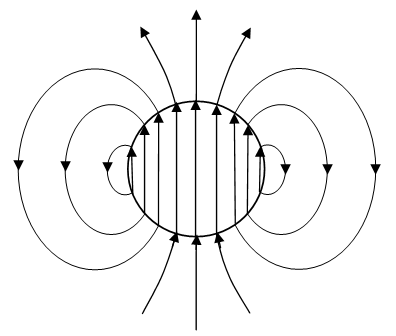 | Figure 1. Associated toroidal vortex |
In the case of the two equal speeds or the same speed of a carrier (V = v), the force (9) and respective energy reduce into their particular, centrally symmetric forms: | (12) |
Although mutually equal – in this particular case, the two speeds keep their distinct roles, concerning the carrier and its object, respectively. The formal comparison with (6) & (7) identifies the static laws as the special cases of these ones, at the two equal, mutually opposite speeds. Unlike the kinetic attraction (12) of two parallel electric currents, two equipolar charges statically repel.
5.2. Mass Variation
The combined force (12a) affects in return the carrier (at V = v). Subtracting from the opposite static force (6a), the result is evenly distributed about the surface: | (13) |
The factor n depends on the radius, and g2 = 1 – (v/c)2 – on speed. This difference of (6a) and (12a) asymptotically tends to zero – towards v = c. Striving to expand the particle radially, it is balanced by the opposite reaction of polarized medium, the same as at rest. The equality f = fo thus gives the two following simple relations: | (14) |
Of course, the same force distributed about the smaller particle surface gives a greater external pressure. The force balance on the surface is satisfied by the two functions (14) – of the radius and mass, dependent on the factor g. The function (14b) was initially estimated on the empirical bases. With respect to (7b), q2 is proportional to the product mr, of the inverse quantities (14). As the only quantized quantity, electric charge is invariant at acceleration.Assuming the constant mass, the integration of the force action law gives the classical kinetic energy: wk-cl = m v2/2. Ascribing this energy to magnetic field of a moving charge, (7b) was thus scaled in the ratio 2/3.With respect to (7a), energy difference of the moving and resting particle represents its kinetic energy: | (15) |
Substitution of (7b) identifies electric energy between the two radii. Fig. 2 compares this one with the classical kinetic energy. Although mutually close – in the beginning, they diverge at the greater speeds. Unlike the classical parabola, (15) approaches the speed v = c, with the infinite energy. Apart from the disparate diagrams, their interpretations are essentially distinct: instead of its former formal sense, the energy is a crucial quantity of each particle.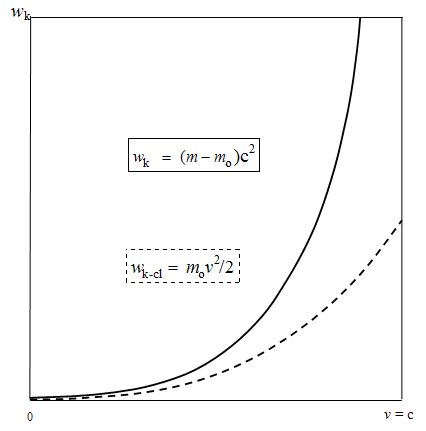 | Figure 2. Kinetic energy against speed |
5.3. Associated & Radiated Photons
The factor g substituted into mass-function (14b) gives the following interesting equation: | (16) |
It reminds a rectangular triangle of linear moments, as the three vectors. However, the speed c – in both left terms – concerns the same direction of the motion, thus forming the two temporal moments. These two cannot form rectilinear triangle with spatial speed (v). Irrespective of this difficulty, the relation (16) is mathematically correct.Its multiplication by c2 gives the less conceivable triangle of the energies, as the scalar quantities: | (17) |
The spatial term, equalled with the photon energy square, gives the associated wave length (17b). The momentum mv accords to the two associated fields (9).Though arbitrarily formulated, the relation (17b) is quite logical. The wave length is proportional to particle diameter (inverse to its mass), and inversely proportional to the speed passing the observing detector. In fact, the apparent wave consists of the moving associated fields.With respect to energetic balances, the radiated energy at the particle stoppage or deceleration cannot exceed the full kinetic energy (15). In the final instance, the following wave length (18b) would be thus obtained: | (18) |
Instead of spatial, the difference of temporal moments is used. Of course, a part of this energy would be consumed by the obstacle causing the stoppage or deceleration. In the case of this cause in the form of the alternating electric field, the particle accepts its energy at acceleration, and releases it in the other half of the oscillating period.
5.4. Accelerated Motion
The variable mass (14b), substituted into force action law, gives the full reactive force, of the transverse (centrifugal) and longitudinal (inertial) components [5]:  | (19) |
Here r = rro is the path curvature radius, and v = vvo – the tangential speed on the path. In the sense of the classical expression – with the constant mass, as if the longitudinal mass is here increased: ml = m/g2. In fact, there are the two distinct functions of the same variable mass. Alike the force (9), this one is resolved into transverse kinetic, and longitudinal dynamic components. The former of them conserves rectilinear motion, but latter one changes the energy. The analogy identifies the former component as magnetic, and latter – as electric forces. The latter force may be understood as the difference of the two dynamic forces (10), being unequal at acceleration.
6. Structural Models
6.1. Elementary Particles
After liberation from a particle, the associated turns into a free photon, Fig. 3. Consisting of the displacement current only, it cannot persist at rest, but in continual motion at the speed of propagation (c). Its toroidal vortex is followed by the circular magnetic, without any electric field. Unlike the particles, centrally symmetric in 3D space, photon is axially symmetric. Though it contains its own energy, it does not manifest electricity, as the divergence of a static, centrally symmetric, electric field. Without their own polarities, the left and right photons manifest similarly.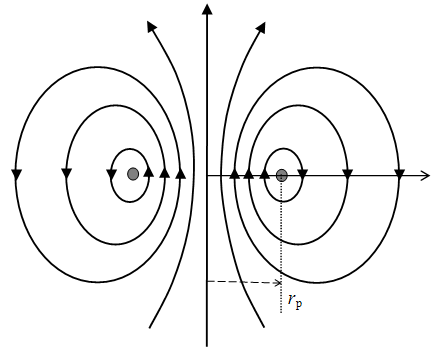 | Figure 3. Free toroidal vortex |
Devoid of a charge, photons do not manifest any inertia. Moving at the speed of propagation, they cannot be further accelerated. However, they are somehow sensitive to the gravitational fields. Apart from the transverse refraction – in non-homogeneous field, a photon changes its energy in the longitudinal such field, equivalently to the variation of the kinetic energy of a massive particle.With respect to presented identification (5) of the electric fields – as the temporal circulations, the model of a charged particle may be a hipper-toroidal vortex, axial to temporal axis, and centrally symmetric in 3D space. Therefore, only one spatial axis (r) is sufficient on Fig. 3, also presenting it. The minimal toroidal vortices, around the circular axis, just represent the 3D surface of respective particle. Also consisting of the displacement currents – elastically deforming the medium, the particle is moving along t-axis. With respect to the common motion of all particles forming the material existence – including subjective observers, they in fact rest in the expanding 3D space. The temporal motion at speed c determines a continual lapse of time. This motion is manifest in the static laws (6) & (7). Its projection into 3D space, evident as the cosmic expansion, depends on the form and essence of the temporal axis.The particle vortex itself is superimposed to the cosmic expansion. With respect to Bernoulli’s effect, their sum and difference cause the opposite pressure disturbances, inside and outside. Such elementary potentials, presented on Fig. 4, accord with the condition Φ = – At, already established. The difference of the internal and external potentials forms the radial pressure on the spherical particle surface. 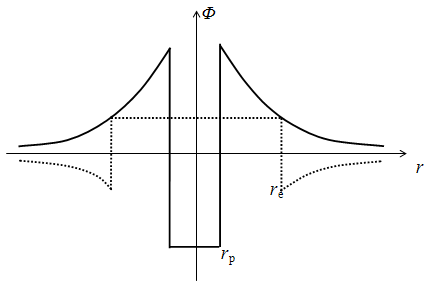 | Figure 4. Elementary central potentials |
The particle polarity accords to the external potential. Fig. 3 thus represents a proton, as the positive charged particle. An electron, as the negative particle, is expressed by the opposite flows, with respective signs of the two pressure disturbances, as the scalar potentials.The internal and external potentials – as the pressures disturbances, are determined by the circulation course of the vortex. The balance with the opposite reaction of medium polarization just determines the particle radius. With respect to the inverse square function (7b), this fact determines the reciprocal ratio of respective two masses.Similar relations may be expected in the substructure of vacuum medium. Owing to the conservation of its mass and energy homogeneities, the pressure gradient is compensated by respective polarization of the structure. Instead of the wave packets, the distinctly oriented and moving vortexes, of the massive or energetic particles, fully explain their phenomenal similarities and distinctions. In both cases, their radii determine the energies, contained in the external fields. These energies are related with particle mass, w = mc2, or frequency (v) of the apparent waves, as the photons: w = hv. The associated and radiated waves are already determined by these two relations.
6.2. Compound Structures
Instead of chemical cluster models, concentric alternation of protons and electrons gives the neutral atomic structures. The smeared electron about the shell of a hydrogen atom is here interpreted as a proton dressed by electron, Fig. 5. The opposite combination, with the needed electron squeezing, represents a neutron. As the difference of the two energies, the remaining energy and mass are located just in the space between the two concentric surfaces.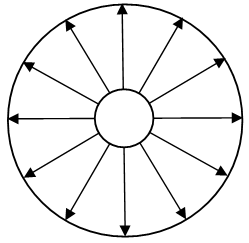 | Figure 5. Hydrogen atom |
The multiple such combinations form atomic nuclei. The electron deficit in a nucleus is compensated on the shells. Such dressing of two photons gives a neutrino, also moving at the speed c through 3D space, without its own charge and mass. The massive particles and photons being combined form – very unstable – moving particles.Some resonant frequencies of elementary and compound particles finally determine their radii. The same resonant states of respective antiparticles are also extremely unstable, with respective inferiority of anti-matter.The mass of a neutral crystal lattice – as the multi-pole – concern the fields between its poles. Mutual cancelation of the distant fields of the opposite poles also causes some mass defect. Of course, this effect is much smaller in the chemical, than in the concentric nuclear structures.Assuming the atomic nuclei as the clusters of elementary particles, some nuclear forces keeping them together were assumed. As the nuclei are inaccessible, these forces could not be directly measured, but were estimated with respect to respective nuclear energies. However, our concentric model overcomes thus estimated nuclear forces.
7. Boundary Relations
7.1. Photons & Waves
From EM wave equation, respective waves are predicted in advance. Owing to two fields in their description, they look more complex than the sound waves. However, instead of the fields, the analogy appears at the two potentials. The static potential accords to the pressure, and kinetic one – to linear momentum density of the undulated medium. Apart from the similar effects (reflection, refraction, diffraction & polarization), both these waves understand respective media of their formation and continual propagation.This analogy is disturbed at light, consisting of photons. Unlike expanding wave, decreasing by square of the path, a photon is moving along its own path. Its energy declines more slowly according the red shift, neglected at the wave – with respect to its expansion in 3D space. Instead of the controversial wave packet, the vortical photon model just explains this distinction of light. Such a photon understands the transverse circular magnetic field. The apparent wave length is proportional to the vortex diameter.In the case of a dipole antenna, its EM radiation is similar to the sound around the oscillating wire. The waves are propagating radially, in the form of the toroidal vortices, instead of the axial photon motion. There arises the question of the relation of these qualitative with quantitative features of the two phenomena. If they were exclusive, a boundary frequency or its transitory region would be between them. Otherwise, possible macro photons and nano-waves could be realized by respective technical devices.
7.2. EM Fields & Gravitation
After reduction of inertia to EM induction, there remains the nature of gravitation and its causal explanation. Unlike bipolar charge and bidirectional electric forces, gravitation is the ever attractive force. With respect to their distinct objects, the two forces are exclusive, and so the former of them cannot be understood as some variation of the latter. Moreover, electric forces are much stronger than gravitation around the elementary charged particles.Due to cancelation of opposite electric fields, gravitation is noticeable around neutral bodies. However, some flow of electrons through a conductor, with their un-manifest fields, forms respective magnetic field, irrespective of the resting lattice and its own field. In fact, the two opposite electric fields coexist in the same location. Their community, in the form of the two opposite temporal flows, may cause the gravitation, as the subtler physical effect.Unlike the proper mass (7b), mutual mass depends only on the distance of two particles, irrespective of their radii. In accord with the above explanation of gravitation, as the mutual interaction, it is expected to be thus independent of the common motion of the interacting bodies. Unlike the variable inertial mass, gravitational one would be invariant, thus disturbing the assumed equivalence.Magnetic field of a celestial body may be related with its rotation in gravitational field of another such body. Rotating around Earth only, the Moon fails in its own magnetic field. The distances between the magnetic and geographic poles of the planets depend on the inclinations of their axes with respect to their orbital planes. The two magnetic poles of the Earth exchange their positions just at the transition through the plane of Galaxy’s symmetry.
7.3. Dark Matter & Energy
On the basis of red shift of the star light, the conclusion of the expanding cosmos, starting by big bang, is obtained. Some estimation of cosmic matter, in the form of the visible bodies, as if points to insufficiency of the mutual gravitation needed for the U-turn of the cosmic process. The invisible mass, needed for the additional gravitation was thus looking for. This expectation is supported by observation of orbital motion of celestial bodies and the light refraction in their vicinity, in the sense of the additional fields of gravitation, possibly belonging to the invisible masses. Instead of the expected U-turn, the increasing red shift of the distant super-nova stars points to possible accelerated expansion. Not only that the dark matter is not renounced, but the notion of dark energy, opposite to the dark matter, is introduced in the science, in order to explain the new effect. On the other hand, our cosmic model presented above, in the form of expanding hipper-spherical wave, exceeds both these two possibilities, the decelerated and/or accelerated cosmic expansion. The noticed increasing red shift should be explained by some other physical causes.
8. Conclusions
By reduction of particles to their fields, potentials and energies, the existence of matter, constituted of the assumed particles, is here overcome. The phenomenal bodies thus represent the energetic images moving through dielectric, non-resistive and reactive medium. These images interact by the known physical forces. Thus affecting the human senses, they give the impression of the material existence. From this level of consideration at least, the omnipresent vacuum medium only, pervaded by energetic fluid, really exists. Apparent confirmation of various material particles is supported by the material existence from the experience, and as such, may be finally overcome.Though invisible and impalpable, the medium may be in solid, rather than in fluidic states. The displacement current and respective vortical particles are founded on the medium polarization. This interpretation understands a substructure of the vacuum medium. Similar to that of matter, it consists of the positive and negative particles, or – of respective two continual fractions, with the similar effects. Of course, the polarization of the medium is elastic. Its reactivity, manifest by dynamic phenomena of inertia and induction, maintains the homogeneous medium density, as its essential feature. Such a medium only may give promising interpretations of the invisible (dark) matter and energy.The above interpretations also influence the cosmology. The motion of matter along temporal axis relates the lapse of time with the cosmic expansion. The gravitation may be also interpreted as the kinetic interaction between the parallel material flows. The matter persistence demands this continual motion, at the speed of propagation. All these features are satisfied by the hipper-spherical cosmic wave, propagating along the radial temporal axis. Riemannian curved space, arbitrarily closed into itself, is thus rationally interpreted. Possible circular form of the temporal axis would cause a periodically pulsating cosmos, without variation of the speed of its propagation. The accelerated expansion may be thus finally excluded.
References
| [1] | B. Mišković, Systematic Foundation of EM Theory, Int. Jour. of Electromagnetics and Applications, 4(1), 2014, |
| [2] | B. Mišković, Boundary Questions of EM Theory, Int. Jour. of Theoretical and Mathematical Physics, 4(3), 2014, |
| [3] | B. Mišković, Medium of Natural Phenomena, Inter. Jour. of Theoretical and Mathematical Physics, 4(4), 2014. |
| [4] | B. Mišković, Relativity and/or Symmetry, Int. Jour. of Theoretical and Mathematical Physics, 4(5), 2014. |
| [5] | B. Mišković, Axiomatic Presentation of EM Theory, SAP, Int. Jour. of Electromagnetics and Applications, 5(1), 2015. |

























 Abstract
Abstract Reference
Reference Full-Text PDF
Full-Text PDF Full-text HTML
Full-text HTML